

https://ebookmass.com/product/the-red-widow-sarah-horowitz/ ebookmass.com
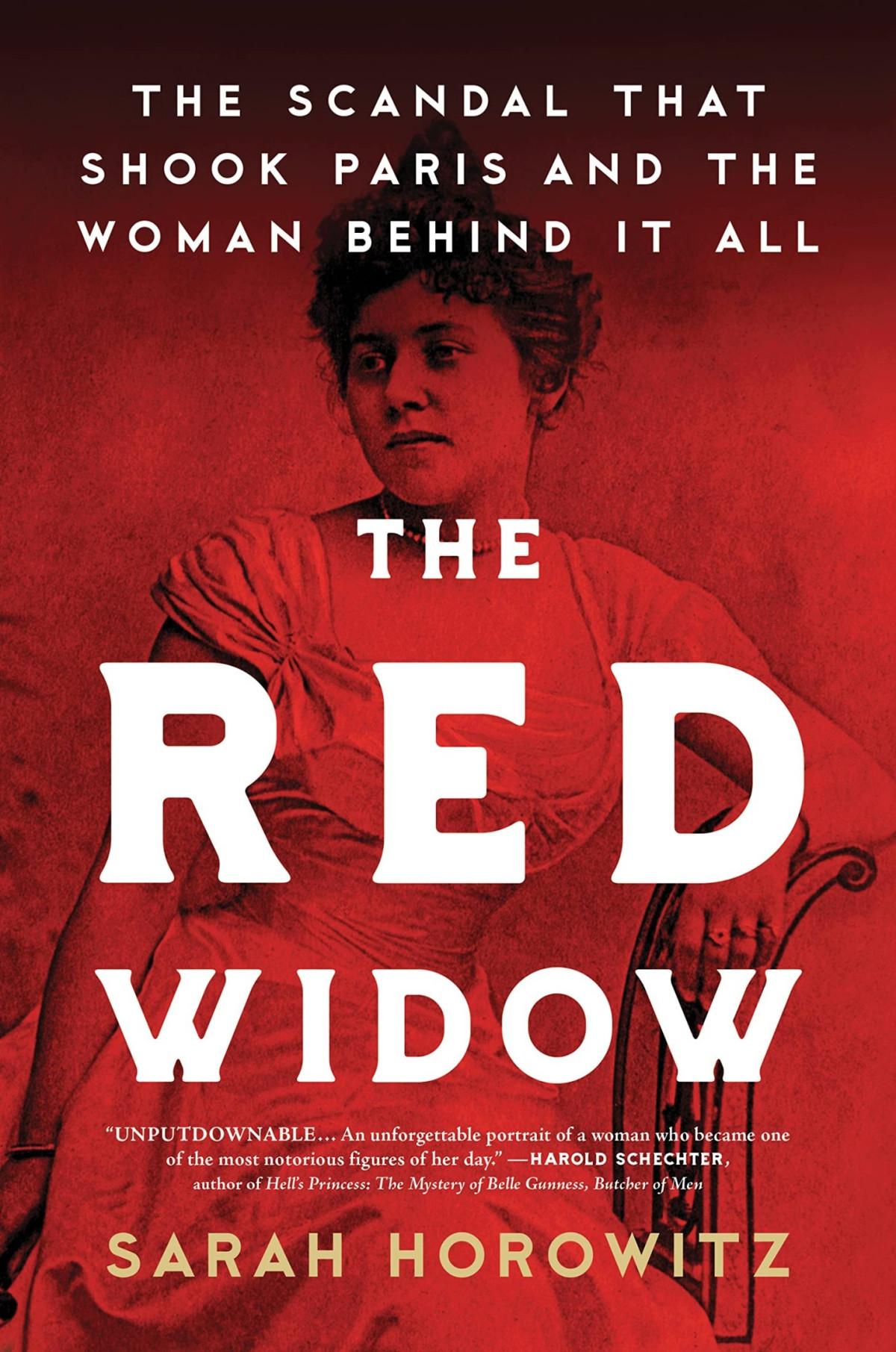
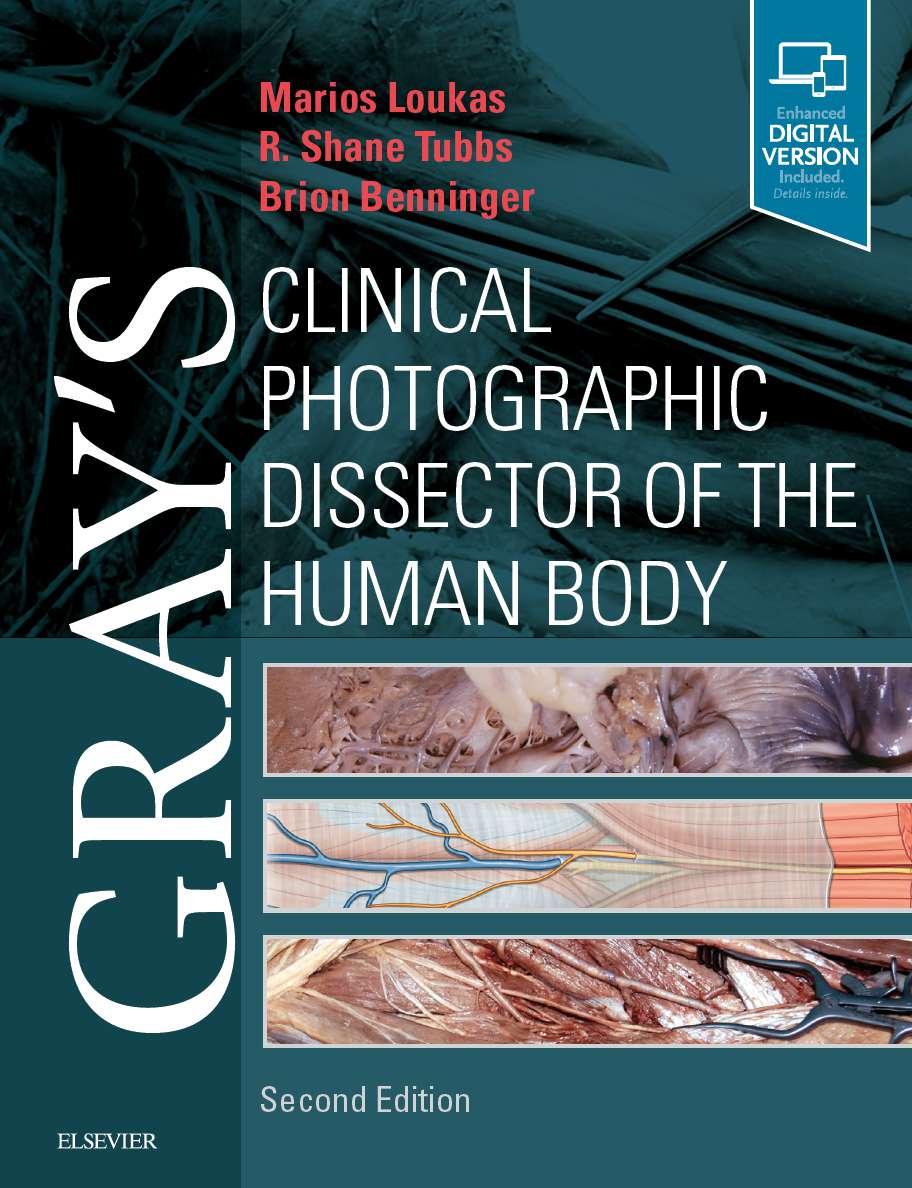
I would like to dedicate this book to my brilliant and wonderful wife, Joanna, who has been the bright star of my life. Her continuous support, dedication, love, and affection give me the energy and courage to fulfill all of our dreams.
ML
I would like to thank my wife, Susan, and son, Isaiah, for their support and patience during the writing of this dissector. All that I do, I do for them. I also want to dedicate this book in memory of my brother-in-law, Nelson Jones, whose intellect, engagement of others, and curiosity about life have been examples for me.
RST
It’s an honor to dedicate this work to Bill Bryan, Jim McDaniel, and Gail Hendricks, who always fought for what is right. I would also like to extend my gratitude to those who provided me with clinical pearls and critical thinking in my training during medical school and as lifelong learners—Gerald Tressidor, Peter Bell, Chris Colton, Harold Ellis, and Lynn Loriaux. Special thanks to Erik Szeto and his family for always thinking of community service and providing for all. Lastly, I am indebted to my wife, Alison, who supports my passions, my son, Jack, who remains forever inquisitive, my father, Roger, for his engineering mind and love of life, and my mother for her fight for equality and education.
BB
Credits
The following plates are from Drake RL et al: Gray’s Atlas of Anatomy, 2nd edition, Philadelphia, Elsevier, 2015.
Plates 2.1, 2.2, 3.1, 3.2, 4.1, 4.2, 5.2, 7.1, 7.2, 8.1 to 8.3, 9.1, 9.2, 10.1 to 10.3, 11.1, 12.2 to 12.4, 13.2, 13.3, 14.1, 14.2, 15.1, 15.2, 16.1 to 16.3, 17.1, 17.2, 18.2 to 18.5, 19.1, 19.2, 20.1, 20.2, 21.1, 21.2, 22.1, 22.2, 23.1, 23.2, 24.1, 24.2, 25.1, 26.2, 27.1 to 27.3, 28.1, 28.2, 29.1 to 29.4
The following plates are from Drake RL et al: Gray’s Anatomy for Students, 3rd edition, Philadelphia, Elsevier, 2015.
Plates 5.1, 6.1 to 6.4, 12.1, 13.1, 18.1, 22.3, 23.3, 24.3, 24.4, 26.1
Also, Mrs Nadica Thomas-Dominique, Ms. Tracy Shabazz, and Ms. Yvonne James for their invaluable assistance.
The following great friends have been very instrumental over the years with their enthusiasm, continuous support, and most important, mentoring in the completion of this and many other projects:
Allen Pensick, PhD
Peter Abrahams, MD
Gene Colborn, PhD
Vid Persaud, MD, PhD
The authors would also like to thank Shivayogi Bhusnurmath, MD, and Bhati Bhusnurmath, MD, for their important comments on the pathological specimens.
The authors would also like to give a very special thank you to Drs. George Salter, Jerzy Walocha, Jerzy Gielecki, and Anna Zurada for their generous efforts in reviewing this book.
A special thanks to our friends and partners in Elsevier for this project — Jeremy Bowes, Rebecca Gruliow, John Casey, and Madelene Hyde
We would like to acknowledge all our former and current students who have kept us thinking fresh and edgy with all their comments to improve the learning and teaching of anatomy.
Finally, we would like to thank those who donated their bodies to anatomical science; without them this project would not have been possible. †Deceased.
Reviewers
In addition to the reviewers listed below, we would also like to acknowledge the valuable contributions of the reviewers of the first edition.
ARGENTINA
Susana Biasutto, PhD Professor, Anatomical Institute National University of Cordoba Cordoba, Argentina
AUSTRALIA
Fiona Stewart, MBBS, BSc Associate Professor, School of Rural Medicine
University of New England Armidale, NSW, Australia
AUSTRIA
Andreas H. Weiglein, MD Vice Chair, Institute of Anatomy Medical University of Graz Graz, Austria
CANADA
Vid Persaud, MD, PhD, DSc, FRCPath (Lond.) Professor Emeritus and Former Head
Department of Human Anatomy and Cell Science University of Manitoba Winnipeg, Manitoba, Canada
CHINA
Changman Zhou, MD, PhD Professor, Department of Anatomy and Embryology
Peking University Health Science Center
Beijing, China
CZECH REPUBLIC
J. Stingl, PhD
3rd Faculty of Medicine Institute of Anatomy Charles University Prague, Czech Republic
FRANCE
Fabrice DuParc, MD, PhD Professor of Anatomy Department of Medicine and Pharmacy
University of Rouen Rouen, France
GERMANY
Reinhard Putz, MD Professor, Institute of Anatomy Ludwig-Maximilians-University of Munich Munich, Germany
INDIA
Subhash D. Joshi, MBBS, MS Dean, SAIMS Medical College Indore, India
IRAN
Mohammadali M. Shoja, MD Medical Philosophy and History Research Center
Tabriz University of Medical Sciences
Tabriz, Iran
ITALY
Raffaele De Caro, MD
Full Professor, Director of Institute of Human Anatomy University of Padova Padova, Italy
JAPAN
Tatsuo Sato, MD, PhD President
Tokyo Ariake University of Medicine and Health Sciences
Tokyo, Japan
NEW ZEALAND
Helen Nicholson, BSc (Hons), MBChB, MD (Bristol)
Professor and Dean
Otago School of Medical Sciences
University of Otago
Otago, New Zealand
Mark Stringer, BSc (Hons), MBBS, MS (Lond), MRCP (UK)
Professor, Department of Anatomy
Otago School of Medical Sciences
University of Otago
Otago, New Zealand
POLAND
Jerzy Gielecki, MD, PhD
Dean for English Division
University of Warmia and Mazury Olsztyn, Poland
Anna Zurada, MD, PhD
Medical Faculty
Department of Anatomy
University of Warmia and Mazury Olsztyn, Poland
SAUDI ARABIA
Abdullah M. Aldahmash Chairman of Anatomy and Director of Stem Cell Unit
College of Medicine
King Saud University
Riyadh, Saudi Arabia
SOUTH AFRICA
Dr. Albert van Schoor, PhD
Senior Lecturer, Department of Anatomy
University of Pretoria
Johannesburg, South Africa
TURKEY
Nihal Apaydin, MD
Associate Professor, Department of Anatomy
Ankara University Ankara, Turkey
UNITED KINGDOM
Bernard Moxham, BDS, PhD, FHEA, FSB
Professor of Anatomy and Head of Teaching in Biosciences President of the International Federation of Associations of Anatomists (IFAA) Cardiff School of Biosciences Cardiff, United Kingdom
Jonathan Spratt, MA(Cantab), FRCS (Eng), FRCS (Glasg), FRCR Consultant Clinical Radiologist University of North Durham Durham, United Kingdom
UNITED STATES
Anthony V. D’Antoni, MS, DC, PhD
Assistant Professor of Anatomy in Radiology Department of Radiology
Weill Cornell Medicine
New York, New York, United States
Camille DiLullo, PhD
Professor, Department of Anatomy
Philadelphia College of Osteopathic Medicine
Philadelphia, Pennsylvania, United States
Anthony Olinger, PhD
Assistant Professor Department of Anatomy
Kansas City University of Medicine and Biosciences
Kansas City, Missouri, United States
David J. Porta, PhD Professor, Department of Biology
Bellarmine University
Louisville, Kentucky, United States
Kyle E. Rarey, PhD Professor, Departments of Anatomy & Cell Biology and Otolaryngology
University of Florida College of Medicine
Gainesville, Florida, United States
George Salter Jr, PhD
Professor Emeritus of Anatomy
University of Alabama at Birmingham Birmingham, Alabama, United States
Carol E.H. Scott-Conner, MD, PhD Professor, Division of Surgical Oncology and Endocrine Surgery Department of Surgery
University of Iowa Carver College of Medicine
Iowa City, Iowa, United States
Joel Vilensky, PhD Professor Emeritus of Anatomy and Cell Biology
Indiana University School of Medicine
Fort Wayne, Indiana, United States
†Deceased
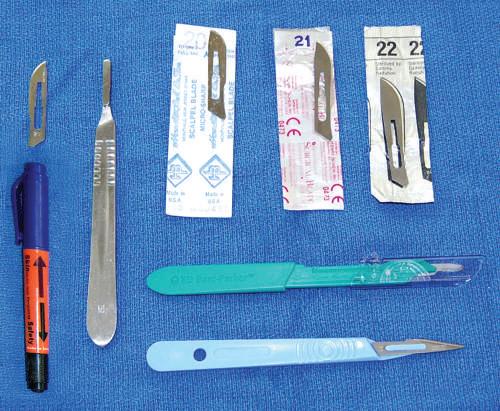
• Sharps bin or container
For safety compliance, all dissection laboratories should have a sharps bin to dispose of scalpel blades, disposable scalpels, pins, and needles.
• Scissors
Both 5-inch and 7-inch straight and curved scissors may be used. It is important that the scissors used for each dissection are appropriate in size (Fig. 1.6). Generally, head and neck dissection can be conducted with 5-inch scissors. The remainder of the body can be dissected with 7-inch scissors. The classic scissor dissection technique is a reverse dissection. Straight and curved scissors tend to be user specific.
• Hemostat clamps
Corrugated and smooth, 5-inch and 7-inch hemostat clamps are available (Fig. 1.7). The corrugated type can be used to clamp onto the edge of skin incisions to aid in flap removal. Smooth clamps can be used to hold onto delicate structures during dissection. Hemostat clamps can be used when retracting tissue over relatively long dissection periods.
• Needle holders
The needle holder allows the user to secure and remove scalpel blades (see Fig. 1.7).
• Forceps
Toothed and nontoothed forceps are either 5 inches or greater than 5 inches long. Toothed forceps enable the dissector to grip tissue without it sliding out of the hands. Nontoothed forceps allow the dissector to control delicate tissues during meticulous dissection without damaging the tissue (see Fig. 1.7).
• Spatula probe/pointer
Instruments that have a probe or tip on one end and spatula on the other can be used to highlight dissected
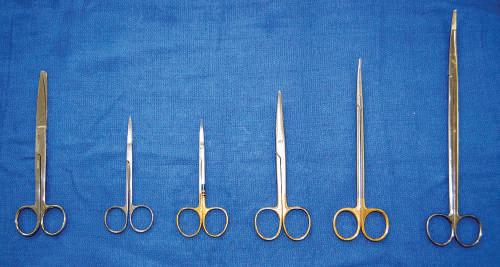
Fig. 1.6 Various scissors differentiated by length and blade type (straight or curved, pointed or blunted): 6-inch Deaver, straight fine scissors, curved fine scissors, 5-inch Mayo, 7-inch Metzenbaum, 9-inch Metzenbaum.
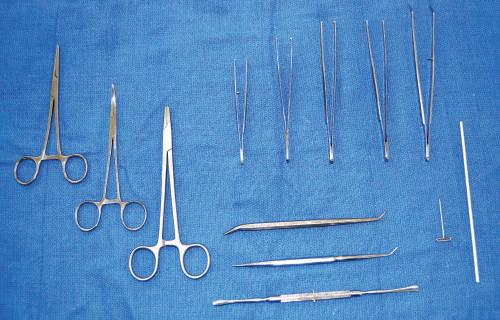
Fig. 1.7 Left, Hemostat or artery clamps (straight and curved). Upper, Needle holder; various forceps differentiated by length, toothed and nontoothed. Lower, Probes and dissectors. Right, T-pin and orange stick.
structures. The spatula can aid blunt dissection (see Fig. 1.7).
• T-pins
T-pins (1 1 2 –2 inches) are useful in securing structures away from the desired dissection region. T-pins also can be used when setting up laboratory examinations (see Fig. 1.7).
• Chisel (osteotome)
Narrow-blade and broad-blade chisels are important for performing osteotomies and can help dissect, for example, between the occipital condyles and various vertebrae (Fig. 1.8). Chisels can be used to break up a bone surface to view the soft tissue deep to it (e.g., anterior cranial fossa).
• Rubber mallet
A mallet is used when striking the chisel to crack surface areas, such as when performing osteotomies (see Fig. 1.8).
• Electric Stryker saw
Used when cutting bone, the Stryker saw has a safety mechanism that prevents the blade from cutting the user’s skin and soft tissue.
bony surface, causing multiple fractured segments while protecting the soft tissue beneath the bone (e.g., fracturing anterior cranial fossa plate before superior orbit dissection) (Fig. 1.16).
• Direct fracturing technique
The direct fracturing technique can be performed using a narrow-bladed chisel or by tilting a broad-bladed chisel so that a direct point touches the bone to be fractured. Strike the chisel head with the mallet as if driving a nail. This technique will fracture through a specific part of outer layer of bone (Fig. 1.17).
• Prying technique
The prying technique requires placing the blade of a chisel into the gap created by a handsaw or electric saw. Once in the gap, rotate the chisel blade using
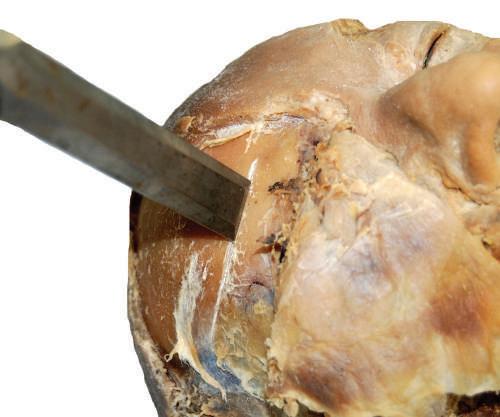
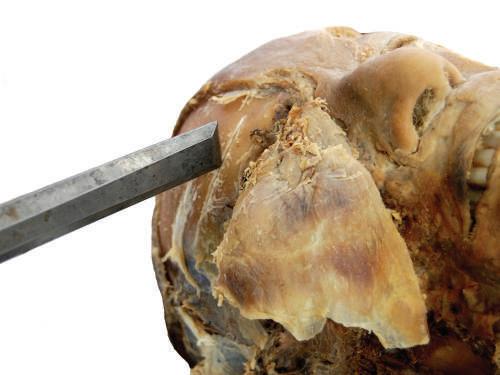
a circular motion of the wrist while gripping the chisel to pry the two bony edges apart. Prying is especially useful when performing a craniotomy (see Chapter 23).
• Stryker saw
The technique for using the electric bone saw is performed by placing the blade directly perpendicular to the bone. Place enough pressure onto the bony surface until the blade has gone through the thickness of the bone. Once through the bone, remove the blade, and assess whether the prying technique is required.
• Stryker saw scoring
The scoring technique requires using a Stryker electric saw blade to score the surface of the bone region to be removed. Often an “X” pattern of scoring can weaken the bony cortex. Once the scoring is completed, use the surface fracturing technique. This allows fracture of the cortex and removal of bony fragments without damaging soft tissue beneath the cortex (e.g., removing outer cortex of mandibular ramus; see Chapter 22).
SPECIALIZED MATERIALS TO HIGHLIGHT STRUCTURES
• Latex solutions
Use latex solutions as an injection to highlight vessels, especially small vessels that may not be easily dissectible.
• Needle and syringe
Multiple syringe sizes and needle sizes are used to inject latex or dye into spaces (Fig. 1.18). Injection of the globe (eyeball) with water also may be useful to obtain lifelike qualities.
• Suture material
Multiple sizes of suture material to reattach dissected structures can be useful when demonstrating
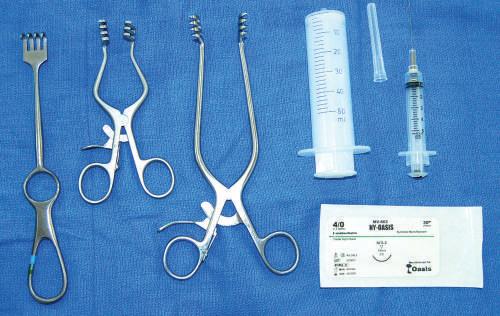
superficial and deep structures after dissection (see Fig. 1.18).
• Retractors
Types include (1) single-handled manual retractor for dynamic traction and (2) self-retractor used to retract two sides simultaneously, allowing the dissector to practice surgical procedures without needing others to retract structures manually (see Fig. 1.18).
• Food coloring
Mix with a solution to inject into the body, to fill up potential spaces and to highlight others.
• Electronic digital calipers
Use to measure specific length, size, and shape of anatomic structures (see Fig. 1.2).
• Plastination
The plastination technique preserves dissected regions or structures to be used as prosected material, with a life span of 6 months to 20 years,

depending on technique, body part, and frequency of use.
• Rongeur and rib cutters
These can be used to cut through small- to medium-sized bones and to customize cut ends of all bone sizes (Fig. 1.19).
DISSECTION TIP
Take precautions to avoid cutting too deeply with the scalpel. In some cadavers, the superficial fascia is very thin, and more deeply situated structures can be cut and destroyed (Figs. 2.5 and 2.6).
o Completely remove superficial fascia over the latissimus dorsi muscle.
o On the other side of the body, the skin and superficial fascia can be reflected together.
DISSECTION TIP
Care must be taken in this latter approach to avoid damage to the underlying muscles, especially the trapezius and latissimus dorsi muscles and their aponeuroses. Identify these before the skin and fascia are reflected more than a few centimeters.
SUPERFICIAL MUSCLES OF THE BACK: PART 1
o Remove enough deep fascia to clarify the borders of the two most superficial muscles of the back, the trapezius and latissimus dorsi (Fig. 2.7).
ANATOMY NOTE
Note the diamond-shaped aponeurotic area of the trapezius at the upper middle thoracic region (see Fig. 2.7). The skin, superficial fascia, and deep fascia are relatively thin here. This is in contrast to the lateral lumbar region, where the amount of subcutaneous fat is increased (see Fig. 2.6).
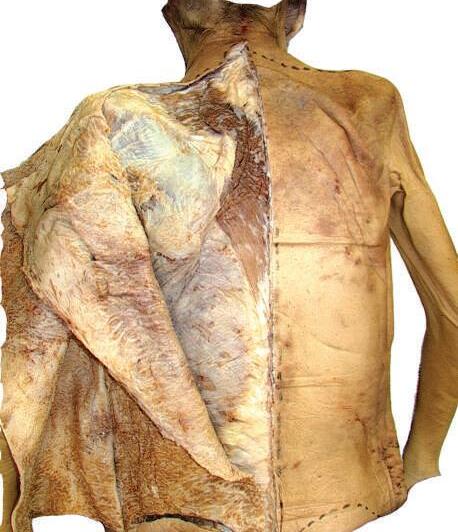
2.5
of deep fascia and appearance of
latissimus dorsi, and thoracolumbar fascia.
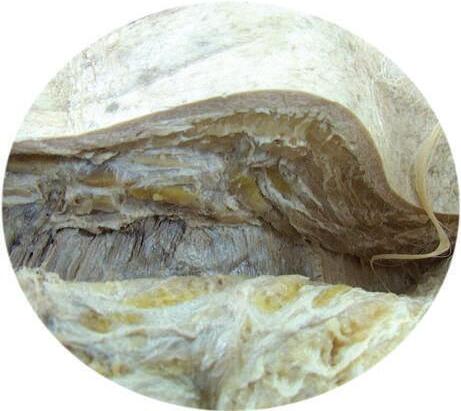

Fig. 2.6 Note possible differences in thickness of the skin and fascia. Avoid cutting too deeply with the scalpel to prevent damage to superficial structures when exposing them.

Fig. 2.13 Complete exposure and detachment of the superior part of the trapezius from the deep fascia. Observe the 3rd occipital nerve.
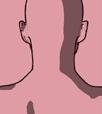

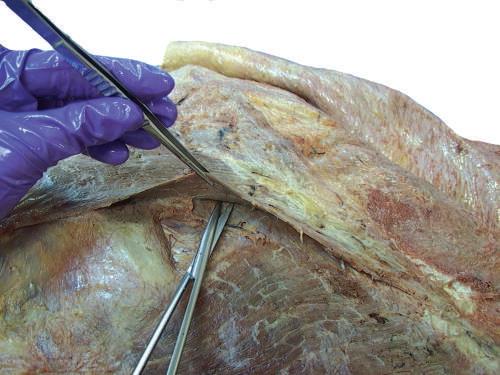
Fig. 2.14 Dissection of lateral trapezius muscle facilitated by a separation technique using dissecting scissors.
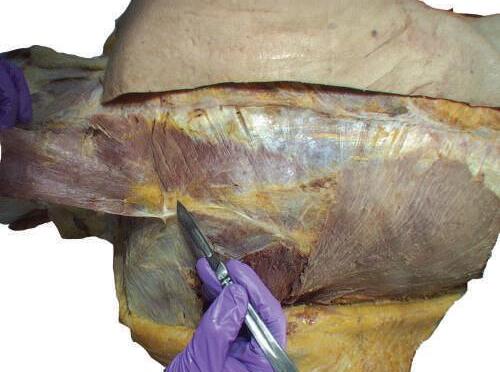
Fig. 2.15 Separation of the connective tissue on the deep surface of trapezius.



Fig. 2.16 Complete reflection of the trapezius and appearance of the underlying levator scapulae and rhomboid muscles, and neuromuscular bundle.


o Gently retract the levator scapulae muscle medially. At the midpoint of the levator, you will see the accessory nerve exit and run on the internal surface of the trapezius muscle (Figs. 2.17 and 2.18).

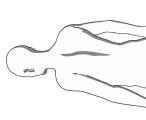
o Carefully separate the neurovascular bundle to identify the accessory nerve, ascending branch of the transverse cervical artery, and tributaries of transverse cervical vein (Figs. 2.19 and 2.20).
o Carefully expose the deep fascia over the rhomboid major and minor muscles. In some specimens the line
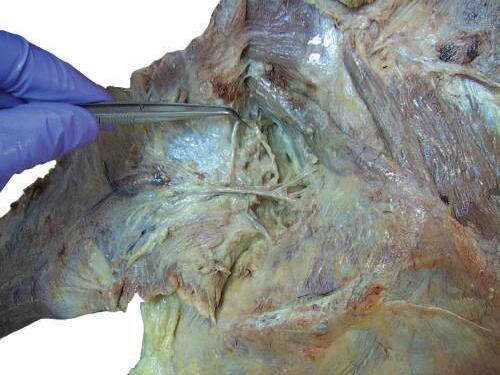
Fig. 2.17 Identification of accessory nerve, emerging deep from medial side at midpoint of levator scapulae muscle.
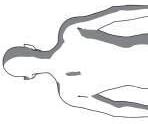

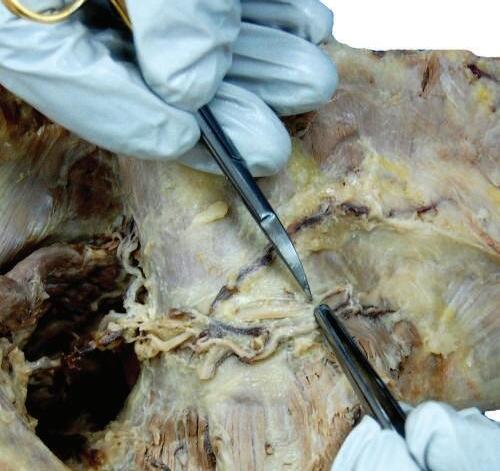
Ascending branch of transverse cervical artery and vein
Fig. 2.18 Careful separation of neurovascular bundle to identify accessory nerve, ascending branch of transverse cervical artery, and tributaries of transverse cervical vein.


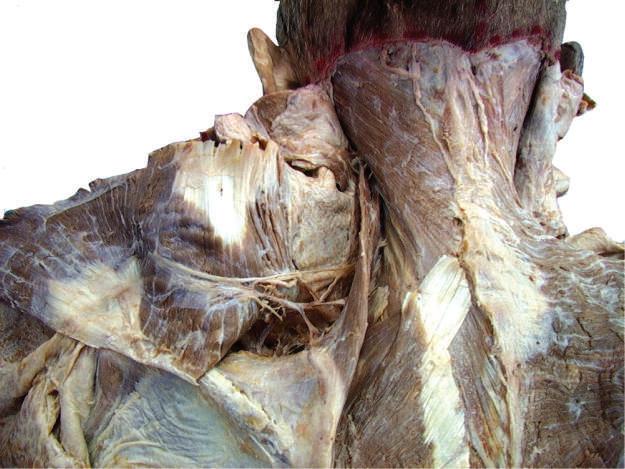
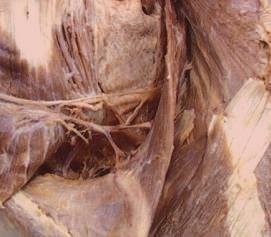
Fig. 2.19 After careful dissection of connective tissue, trapezius muscle is reflected and accessory nerve identified.




2.21 Carefully expose deep fascia over the rhomboid major and minor muscles.


Fig. 2.20 Trapezius muscle is reflected and the accessory nerve identified.


of cleavage between the rhomboid muscles may be unclear (Figs. 2.21 and 2.22).
o Reflect the rhomboid muscles laterally toward their insertion onto the medial border of the scapula (Fig. 2.23) (Plate 2.1).
o Deep to the rhomboids, identify the serratus posterior superior muscle, which inserts onto the ribs rather than onto the scapula. (This fact will assist you in its identification.)
o On the deep surface of the rhomboids, try to identify the dorsal scapular nerve and dorsal scapular artery (Fig. 2.24).
ANATOMY NOTE
The dorsal scapular nerve innervates the rhomboid and levator scapulae muscles (in addition to branches from C3 and C4). The dorsal scapular nerve arises from C5, one of the two nerves that arise directly from the ventral rami of the brachial plexus.
ANATOMY NOTE
In about 50% of the specimens, the dorsal scapular artery is absent, and the deep branch of the transverse cervical artery replaces it. The dorsal scapular artery typically arises from the 3rd part of the subclavian artery and runs posteriorly through the brachial plexus.
MUSCLES OF THE SCAPULA
ANATOMY NOTE
The infraspinous fascia is attached to the scapula around the boundaries of the attachments of the infraspinatus, teres minor and major, long head of triceps brachii, and deltoid muscles.
o Clean the teres major muscle (Fig. 2.25).
o Identify the teres minor and deltoid muscles and the long head of triceps brachii (Fig. 2.26).
ANATOMY NOTE
The fibers of the teres minor muscle run more or less parallel to the fibers of the teres major and are medial to the long head of the triceps brachii and deltoid muscles (see Fig. 2.25).
o Beginning superiorly, reflect the infraspinous fascia to expose the long head of triceps and deltoid muscles (Figs. 2.27 and 2.28).
